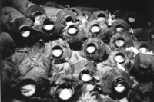A team of oceanographers and archaeologists including MIT Professor David Mindell discovered two ancient Phoenician ships wrecked in the Mediterranean Sea off the coast of Israel. The ships are the oldest ever found in the deep sea.
The expedition team, led by oceanographer Robert D. Ballard of the Institute for Exploration in Mystic, CT, discovered the ships on June 11 more than 1,000 feet below the surface using advanced deep-sea sonar equipment. The team made detailed sonar map images of the parts of the ships covered by mud using an instrument developed by Mindell, who is the Dibner Professor of the History of Engineering and Manufacturing.
The scientists believe the ships were lost in a violent storm while traveling from Phoenicia (now Lebanon) to Egypt or Carthage in about 750 BC laden with a cargo of wine stored in ceramic amphorae.
The larger of the two ships is about 18 meters (58 feet) long; the other measures about 48 feet. Heavy stone anchors lie at the bow and midship. Crockery for food preparation, an incense stand and a wine decanter mark the galley. These and other items leave little doubt that Phoenician crews occupied the two ships, according to Lawrence Stager of Harvard University, who led the team of archaeologists on the expedition.
ENGINEERING FEAT
Archaeology in the deep sea is made possible by remotely operated vehicles capable of scanning the bottom of the ocean with great precision at depths of up to 6,000 meters. This new ability to find shipwrecks, thoroughly document their position and recover artifacts from them at depths well below the reach of scuba divers suddenly placed ships that went down in the deep seas within the scope of archaeologists.
Jason, the remotely operated vehicle that was used on the current expedition in the Mediterranean, was built at the Woods Hole Oceanographic Institution (WHOI) and partially designed by Professor Mindell. Jason was equipped with lights and television cameras to transmit images back up to the ship's control room.
Once the Jason robot located the Phoenician ships, the investigators obtained detailed sonar map images of the sites, using a new instrument designed by Professor Mindell to map the parts of the ships submerged in mud. That instrument, called a sub-bottom profiler, uses narrowly focused sound beams combined with the precise control of Jason to "see" those areas of the shipwrecks covered by soil on the ocean floor.
"This is the first time anything of this sort has been tried," said Professor Mindell. "It was a great success and clearly reveals the ship's structure and location under a pile of exposed amphoras. The maps also provide critical information to the project's archaeologists about how the ship sank and helps the planning for a future excavation.
"The goal is to allow an archaeologist to do 'virtual excavation,' by simply peeling off layers in a computer model, without the need to actually dig -- or with much less digging than would otherwise be necessary," said Professor Mindell.
Based on the images obtained using this technology and a number of artifacts recovered from the sites, archaeologist Stager was able toestablish the ships' age, origin, cargo and probable destination.
The ships are the oldest ever found in the deep sea, Dr. Ballard said; the oldest shipwreck ever discovered was a trading ship from 1300 BC, found in less that 200 feet of water off Turkey.
Professor Mindell, an electrical engineer and historian of science and technology, participated in the 1987 Mediterranean Sea expedition with Dr. Ballard that yielded amphorae and other artifacts from ancient Rome and Carthage. He was also a member of the search and survey team on the National Geographic Midway expedition that discovered the USS Yorktown more than three miles deep in the Pacific Ocean last year.
Professor Mindell and MIT hosted the first conference on deep sea archaeology in January 1999, which brought together scientists from around the world who believe that the new field will allow archaeologists to piece together the trade routes of the ancient world.
The current expedition was sponsored in part by the National Geographic Society, the US Office of Naval Research and Leon Levy. Dana Yoerger and Hanument Singh of WHOI, Shelly Wachsmann of the Institute of Nautical Archaeology at Texas A&M University and Louis Whitcomb of Johns Hopkins University were also key players in the expedition.
A version of this article appeared in the July 14, 1999 issue of MIT Tech Talk (Volume 44, Number 1).






